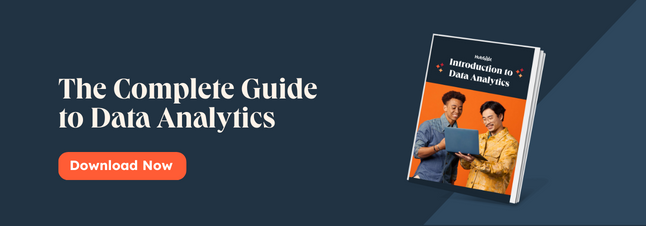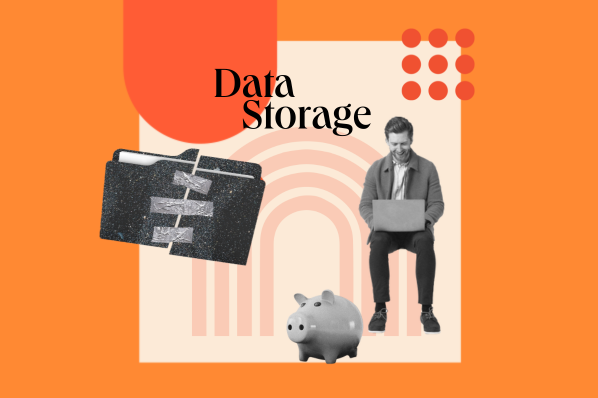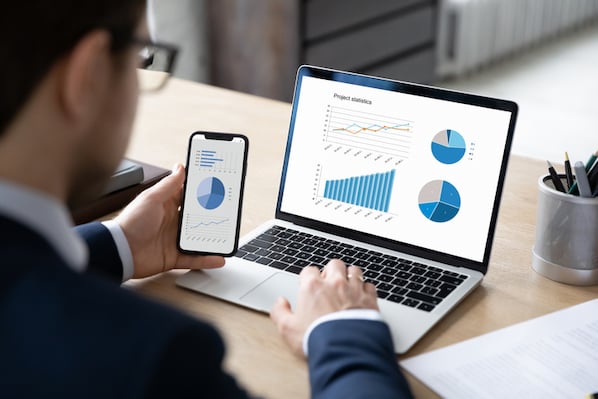The 5 Vs of Big Data
Big data is unique in that its volume, velocity, and variety are all much higher than can be handled manually. By nature, big data delivers richer and more subtle insights than can ever be achieved with standard data collection and analysis.
Volume
The amount of data that exists in the digital world is astronomical. Seed Scientific estimated that there were 44 zettabytes of data in the world as of 2020 and expects that number to nearly quadruple to 175 zettabytes by 2025. (A single zettabyte is equal to one trillion gigabytes.)
Although an individual company will have far less data, it could still be a lot to manage. For just a single terabyte of data, you'll need an automated way to parse through it efficiently in order to have the most holistic view of your customers' past, present, and even hypothesized future data points.
At this volume, it's no wonder that big data is as prominent of an industry as it is and businesses of all sizes are making an effort to understand it.
Velocity
Data velocity isn't applicable to every industry or even every business, but it is a critical V in the 5 Vs of big data. At high data velocities, you work with real-time data that's updated to the minute and shows the most relevant insights.
Some examples of high velocity data include:
- An online store that tracks clicks on a screen for every customer who is browsing the site
- A navigation app that collects and sends data to a each traveler
- A social media network that tracks how long a user looks at a post and the types of posts they engage with
This data moves quickly by the individual user it's being collected from, but when you multiply that by thousands and even millions of users, the velocity increases exponentially.
Variety
A high variety of data helps you discover subtle nuances within your database. With data variety, you can maintain a personalized experience for your customers.
Businesses can intentionally limit the variety of their data if they don't have explicit plans to use it. For example, some tech companies don't ask customers for a physical address when they make a purchase if the company has no intentions of mailing materials or tracking location data. On the other hand, some businesses, like Google, collect business addresses for verification purposes.
Veracity
A common need when managing data is accuracy. This can become troublesome when switching between data management systems, poor implementation of the data management system, or even poor adoption of that system within the analytics team.
With high data veracity, you can trust that you're working with clean, consistent, and accurate data that enables you to make sound business decisions.
When you combine these five Vs, you can obtain the most value from big data in your business.
Types of Big Data You Can Extract Value From
There are many different types of big data. Some examples include:
- Lead data and demographics
- Website and product usage data
- Customer purchase data
These can be interpreted individually or in tandem to create a more in-depth view. For the most accurate and insightful view of your data, you can sync data between your apps to enrich each platform's data and create a standardized view of your contacts on every app.
Learn More About HubSpot's Operations Hub Software
How to Use Big Data in Business
An effective data strategy is a key driver for business success. There are several use cases for big data, but one of the most impactful is using big data for business improvement. Reliable Software Inc. created a quick, straightforward guide to using big data for this purpose.
But even if we know the value of big data, why precisely is big data beneficial for businesses? There are four main benefits of big data for large and small businesses (as well as non profit organizations).

The Benefits of Big Data
1. Improving Customer Experiences
When you collect data about your leads and customers, you can track trends to deliver the best customer service throughout their journey with your company. One unconventional but highly effective example of this is the "House of Cards" series on Netflix.
Netflix used the big data it had collected on its viewers to proactively determine what they might like to see. As New York Times explained: "[Netflix] already knew that a healthy share had streamed the work of David Fincher, the director of The Social Network, from beginning to end. And films featuring Kevin Spacey had always done well, as had the British version of "House of Cards." Netflix took the risk of putting down $100 million for two seasons.
Essentially, data determined the creative direction of "House of Cards" and delivered viewers with exactly what they wanted to see.
2. Solving Problems
Big data can be used to identify blockers in business processes and funnels and remedy these with diagnostic data analysis. Uber is one example of this. Uber has been honing its big data solution to forecast rider demand during high traffic events and even identify and address bottlenecks in the driver sign-up process. Uber Movement now shares anonymized data aggregated from over ten billion trips to help urban planning around the world.
3. Increasing Revenue
Revenue is closely tied to customer experience. By using big data to deliver tailor-fit recommendations for every viewer, Netflix has an estimated churn rate of just 9%. Big data enables businesses to also increase revenue by iterating existing products and designing new launches around proven customer needs.
4. Cutting Costs
According to NewVantage Venture Partners, the top advantage of big data is decreasing expenses. By nature, big data works at scale — it removes the need to manually collect and analyze data, which, alongside reduced churn, comes with big cost savings.
Keeping Big Data Ethical
Big data has received a bad rep due to privacy concerns widely associated with Meta (formerly Facebook), but it can and should be handled ethically and effectively. The key fundamentals of big data are privacy, transparency, and security. These are already important for any business to implement in order to meet data protection regulations such as the GDPR.
Key Principles for Big Data Ethics
- Customers should have a transparent view of how their data is processed, used, or shared.
- Customers should be able to manage their data and have the option for it to be removed.
- Data should be stored securely with efforts made to maintain physical and digital integrity.
- Data should be removed once it is no longer required according to data protection regulations.
Don't forget about the human side of data.
The more data you have, the more complexity there is. This means noise and false correlation. While algorithms can help you correct these issues, common sense and gut instinct can still go a long way.
How to Analyze Big Data
There are four main types of data analysis that can be valuable for businesses, including when handling big data: descriptive, diagnostic, predictive, and prescriptive.
- Descriptive analysis shows what is happening now based on incoming data, often via a real-time dashboard or email reports.
- Diagnostic analysis takes a look at past performance to determine what happened and why, often in the form of an analytic dashboard.
- Predictive analysis forecasts likely scenarios of what might happen.
- Prescriptive analysis reveals what actions should be taken and usually results in rules and recommended next steps.
Remember that data in itself isn't meaningful. For it to be valuable to your business, you need to turn data into information. This happens when data is processed, structured, and given context.
The businesses that use big data most effectively have a reliable data management strategy, insightful reporting, and focused analysis of the areas that matter.
Example Uses of Big Data in a Small Business
Sales lead scoring
Lead scoring is enabled by predictive analysis and ranks prospects against a scale to calculate their perceived value.
If you've found out that prospects in France who work in ecommerce are your ideal client, you can award points to the leads that fit this definition and detract points for other leads with negative attributes. By carrying out this analysis, your sales team can focus on the highest-value prospects.
Marketing automation
Big data goes hand-in-hand with marketing automation. By collecting big data that offers insights into your key customer segments, you can create tailored marketing communications that are triggered at key moments in the customer journey.
An example of marketing automation powered by big data includes email campaigns with a goal to increase sales. By using a customer's past purchases, a business can use these data points to predict what that customer may purchase next and send personalized emails to inspire another purchase.
Optimizing your product
Big data highlights what's working and what isn't for your product. If data shows that most of your customers ignore a certain feature or spend a very short time engaging with it, it can be a sign to discontinue or adjust the offering to create a stronger overall product.
User onboarding software and heat maps are two common ways companies collect data about new product features. Once analyzed, this data can be critical to the future success of a product — ultimately determining whether it stays or is discontinued.
Launching new marketing content
You can also use big data to identify opportunities to expand in the market. When the right data points are collected and analyzed correctly, you can quickly find where the highest marketing ROI is.
Website engagement in particular can offer valuable data to influence the direction of your marketing strategy. If you discover that your travel agency's blog posts on kayaking in Norway are driving plenty of organic leads, you could create a more valuable opt-in such as a downloadable guide or webinar on adventure travel in Norway.
Introducing Big Data Analytics in Your Business
Big data isn't just for huge enterprises. In fact, there's value for every type of business, including the smallest organizations. Start by looking at the data you already collect and identify opportunities to collect and analyze new data. Next, explore your opportunities to put the insights to use for the greatest impact on your business and for your customers.
Editor's note: This post was originally published in December 2020 and has been updated for comprehensiveness.











